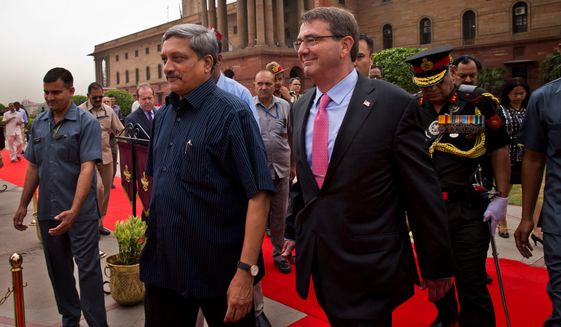Countries including Vietnam, the Philippines and Brunei have disputed Beijing’s claims on the sea.
The Pentagon on Thursday declined to comment on Mr. Carter’s objectives during the trip, but the defense secretary said during a stay in Singapore that he expected countries such as Vietnam and India to play growing roles in regional security.
“That’s what the United States believes in and is championing: a vibrant Vietnam. It’s eager to do more, and we’re doing more with them. And India, an India that’s not only rising economically and militarily but is also a regional security provider now and in the future,” he said.
Douglas Paal, vice president for studies at the Carnegie Endowment for International Peace, said cooperation in the South China Sea may be a long-term goal of a better relationship with India, but nothing in Wednesday’s agreement specifically mentioned the tension-filled international waterway.
“There’s really nothing explicitly in the agreement about the South China Sea,” he said. “Carter’s visit is about bilateral India relations and setting up a framework for 10 years of strategic discussions. In those, I’m sure the South China Sea will be a topic, but what it will mean practically is very unclear from what we know so far.”
Mr. Carter left May 27 for his second trip to Asia since taking office in February. He spent 10 days in Singapore, Vietnam and India to “reaffirm the U.S. rebalance to the Asia-Pacific,” Pentagon spokesman Col. Steve Warren said at the beginning of the trip.
During the trip, Mr. Carter spoke at the Shangri-La Dialogue in Singapore on Saturday and rebuked China for building artificial islands in the South China Sea that have increased tensions in the region.
Several nations, including the Philippines and Vietnam, have developed outposts in the contested waterway, but China has claimed more than 2,000 acres of land — more than all the other countries combined — in the past 18 months Mr. Carter said.
“We’ve all benefited from free and open access to the South China Sea and the Strait of Malacca. We all have a fundamental stake in the security of the South China Sea,” Mr. Carter said during the Singapore speech. “That’s why we all have deep concerns about any party that attempts to undermine the status quo and generate instability there.”
Mr. Lohman said the emphasis on building relationships with India, which began during the George W. Bush administration, is partly to increase the number of partners in the region to protect U.S. and international interests, but there is more to it.
“It’s getting friends and allies to protect the current order, basically,” he said. “What we have established in the Western Pacific after 70 years, it’s to preserve that and the Indians can be a part of that, but it’s a long process.
“The South China Sea is just part of our reason for getting closer to India,” he said. “Even where it’s about China, it’s going to be about more than just the South China Sea. It’s about India’s border, their long-standing rivalry with the Chinese, it’s about a lot.”
Read more: http://www.washingtontimes.com/news/2015/jun/4/us-india-join-forces-to-counter-beijing-aggression/#ixzz3cDxGG51k
Follow us: @washtimes on Twitter


No comments:
Post a Comment